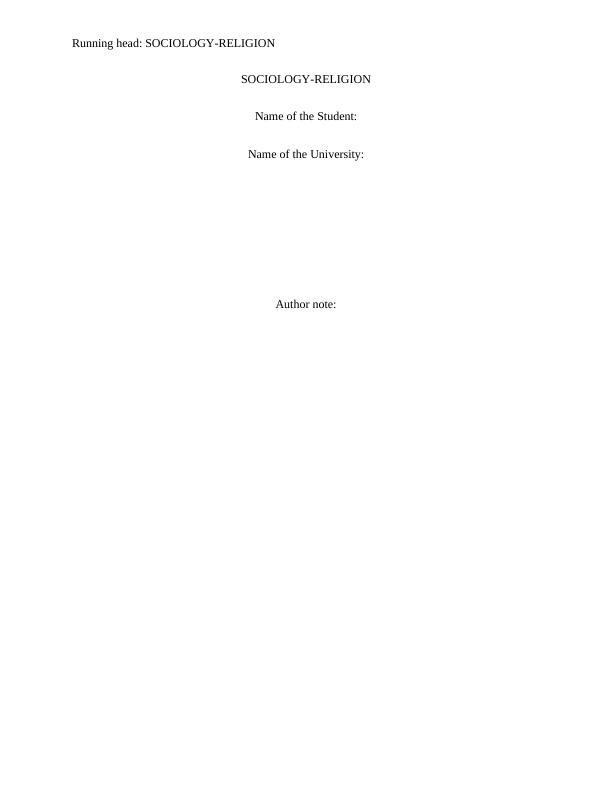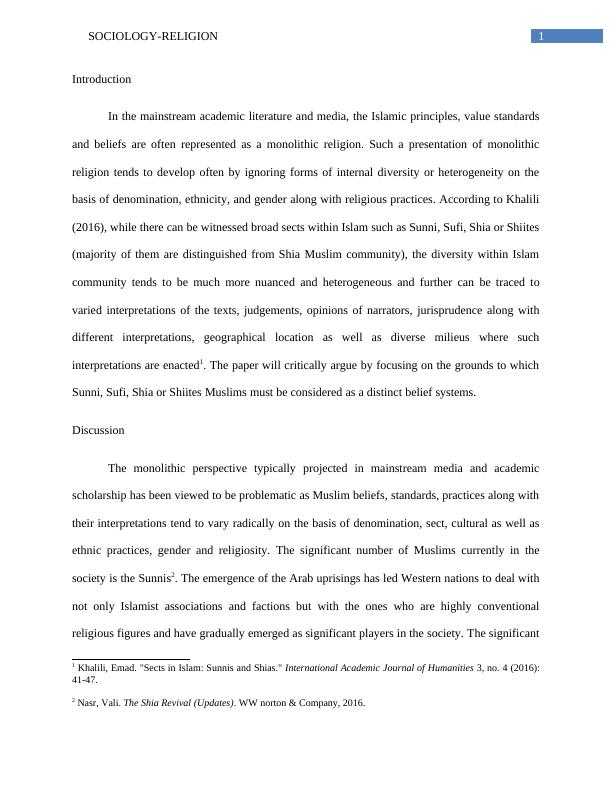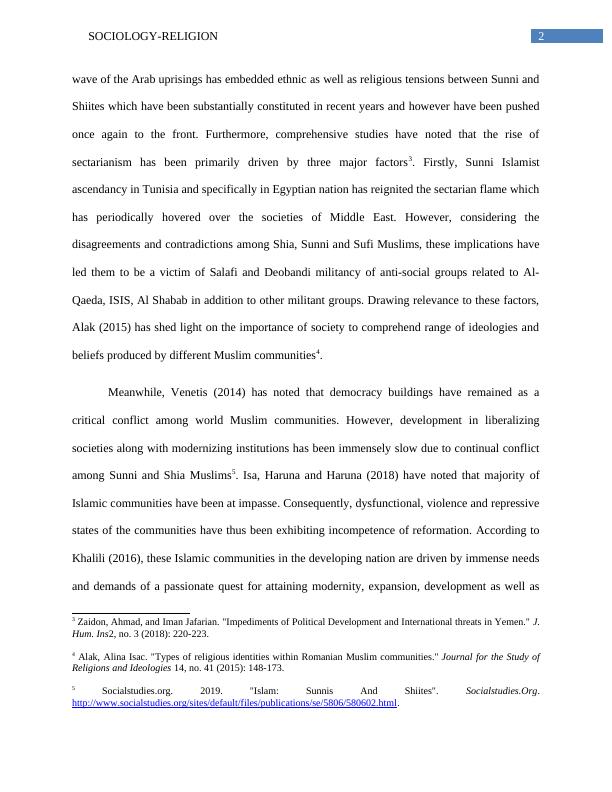Understanding the Diversity within Sunni, Sufi, Shia or Shiites Muslims
Added on 2023-01-16
9 Pages2469 Words62 Views
Running head: SOCIOLOGY-RELIGION
SOCIOLOGY-RELIGION
Name of the Student:
Name of the University:
Author note:
SOCIOLOGY-RELIGION
Name of the Student:
Name of the University:
Author note:

1SOCIOLOGY-RELIGION
Introduction
In the mainstream academic literature and media, the Islamic principles, value standards
and beliefs are often represented as a monolithic religion. Such a presentation of monolithic
religion tends to develop often by ignoring forms of internal diversity or heterogeneity on the
basis of denomination, ethnicity, and gender along with religious practices. According to Khalili
(2016), while there can be witnessed broad sects within Islam such as Sunni, Sufi, Shia or Shiites
(majority of them are distinguished from Shia Muslim community), the diversity within Islam
community tends to be much more nuanced and heterogeneous and further can be traced to
varied interpretations of the texts, judgements, opinions of narrators, jurisprudence along with
different interpretations, geographical location as well as diverse milieus where such
interpretations are enacted1. The paper will critically argue by focusing on the grounds to which
Sunni, Sufi, Shia or Shiites Muslims must be considered as a distinct belief systems.
Discussion
The monolithic perspective typically projected in mainstream media and academic
scholarship has been viewed to be problematic as Muslim beliefs, standards, practices along with
their interpretations tend to vary radically on the basis of denomination, sect, cultural as well as
ethnic practices, gender and religiosity. The significant number of Muslims currently in the
society is the Sunnis2. The emergence of the Arab uprisings has led Western nations to deal with
not only Islamist associations and factions but with the ones who are highly conventional
religious figures and have gradually emerged as significant players in the society. The significant
1 Khalili, Emad. "Sects in Islam: Sunnis and Shias." International Academic Journal of Humanities 3, no. 4 (2016):
41-47.
2 Nasr, Vali. The Shia Revival (Updates). WW norton & Company, 2016.
Introduction
In the mainstream academic literature and media, the Islamic principles, value standards
and beliefs are often represented as a monolithic religion. Such a presentation of monolithic
religion tends to develop often by ignoring forms of internal diversity or heterogeneity on the
basis of denomination, ethnicity, and gender along with religious practices. According to Khalili
(2016), while there can be witnessed broad sects within Islam such as Sunni, Sufi, Shia or Shiites
(majority of them are distinguished from Shia Muslim community), the diversity within Islam
community tends to be much more nuanced and heterogeneous and further can be traced to
varied interpretations of the texts, judgements, opinions of narrators, jurisprudence along with
different interpretations, geographical location as well as diverse milieus where such
interpretations are enacted1. The paper will critically argue by focusing on the grounds to which
Sunni, Sufi, Shia or Shiites Muslims must be considered as a distinct belief systems.
Discussion
The monolithic perspective typically projected in mainstream media and academic
scholarship has been viewed to be problematic as Muslim beliefs, standards, practices along with
their interpretations tend to vary radically on the basis of denomination, sect, cultural as well as
ethnic practices, gender and religiosity. The significant number of Muslims currently in the
society is the Sunnis2. The emergence of the Arab uprisings has led Western nations to deal with
not only Islamist associations and factions but with the ones who are highly conventional
religious figures and have gradually emerged as significant players in the society. The significant
1 Khalili, Emad. "Sects in Islam: Sunnis and Shias." International Academic Journal of Humanities 3, no. 4 (2016):
41-47.
2 Nasr, Vali. The Shia Revival (Updates). WW norton & Company, 2016.

2SOCIOLOGY-RELIGION
wave of the Arab uprisings has embedded ethnic as well as religious tensions between Sunni and
Shiites which have been substantially constituted in recent years and however have been pushed
once again to the front. Furthermore, comprehensive studies have noted that the rise of
sectarianism has been primarily driven by three major factors3. Firstly, Sunni Islamist
ascendancy in Tunisia and specifically in Egyptian nation has reignited the sectarian flame which
has periodically hovered over the societies of Middle East. However, considering the
disagreements and contradictions among Shia, Sunni and Sufi Muslims, these implications have
led them to be a victim of Salafi and Deobandi militancy of anti-social groups related to Al-
Qaeda, ISIS, Al Shabab in addition to other militant groups. Drawing relevance to these factors,
Alak (2015) has shed light on the importance of society to comprehend range of ideologies and
beliefs produced by different Muslim communities4.
Meanwhile, Venetis (2014) has noted that democracy buildings have remained as a
critical conflict among world Muslim communities. However, development in liberalizing
societies along with modernizing institutions has been immensely slow due to continual conflict
among Sunni and Shia Muslims5. Isa, Haruna and Haruna (2018) have noted that majority of
Islamic communities have been at impasse. Consequently, dysfunctional, violence and repressive
states of the communities have thus been exhibiting incompetence of reformation. According to
Khalili (2016), these Islamic communities in the developing nation are driven by immense needs
and demands of a passionate quest for attaining modernity, expansion, development as well as
3 Zaidon, Ahmad, and Iman Jafarian. "Impediments of Political Development and International threats in Yemen." J.
Hum. Ins2, no. 3 (2018): 220-223.
4 Alak, Alina Isac. "Types of religious identities within Romanian Muslim communities." Journal for the Study of
Religions and Ideologies 14, no. 41 (2015): 148-173.
5 Socialstudies.org. 2019. "Islam: Sunnis And Shiites". Socialstudies.Org.
http://www.socialstudies.org/sites/default/files/publications/se/5806/580602.html.
wave of the Arab uprisings has embedded ethnic as well as religious tensions between Sunni and
Shiites which have been substantially constituted in recent years and however have been pushed
once again to the front. Furthermore, comprehensive studies have noted that the rise of
sectarianism has been primarily driven by three major factors3. Firstly, Sunni Islamist
ascendancy in Tunisia and specifically in Egyptian nation has reignited the sectarian flame which
has periodically hovered over the societies of Middle East. However, considering the
disagreements and contradictions among Shia, Sunni and Sufi Muslims, these implications have
led them to be a victim of Salafi and Deobandi militancy of anti-social groups related to Al-
Qaeda, ISIS, Al Shabab in addition to other militant groups. Drawing relevance to these factors,
Alak (2015) has shed light on the importance of society to comprehend range of ideologies and
beliefs produced by different Muslim communities4.
Meanwhile, Venetis (2014) has noted that democracy buildings have remained as a
critical conflict among world Muslim communities. However, development in liberalizing
societies along with modernizing institutions has been immensely slow due to continual conflict
among Sunni and Shia Muslims5. Isa, Haruna and Haruna (2018) have noted that majority of
Islamic communities have been at impasse. Consequently, dysfunctional, violence and repressive
states of the communities have thus been exhibiting incompetence of reformation. According to
Khalili (2016), these Islamic communities in the developing nation are driven by immense needs
and demands of a passionate quest for attaining modernity, expansion, development as well as
3 Zaidon, Ahmad, and Iman Jafarian. "Impediments of Political Development and International threats in Yemen." J.
Hum. Ins2, no. 3 (2018): 220-223.
4 Alak, Alina Isac. "Types of religious identities within Romanian Muslim communities." Journal for the Study of
Religions and Ideologies 14, no. 41 (2015): 148-173.
5 Socialstudies.org. 2019. "Islam: Sunnis And Shiites". Socialstudies.Org.
http://www.socialstudies.org/sites/default/files/publications/se/5806/580602.html.

End of preview
Want to access all the pages? Upload your documents or become a member.
Related Documents
Understanding Kuwait's Legal System, Court System, and Court Levelslg...
|8
|1979
|222